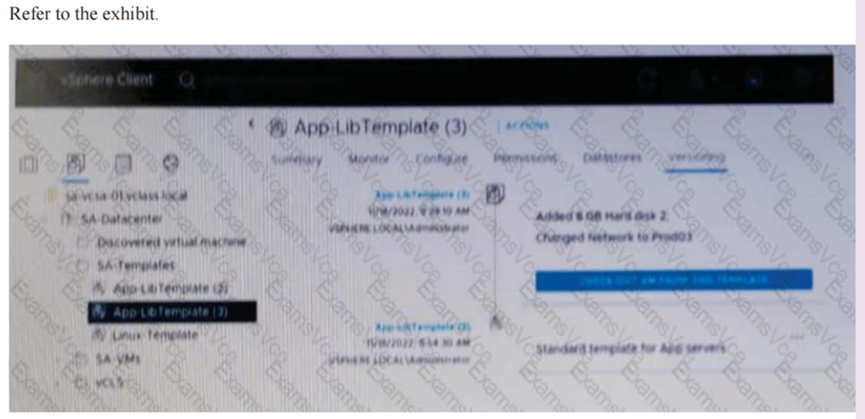

A、 VMware Aria Operations for Logs
B、 VMware Skyline Advisor Pro
C、 VMware Skyline Health
D、 VMware Aria Operations
答案:C
解析:解析: The solution that should be recommended to reduce the risk of outages by proactively identifying and resolving issues with the environment and reducing the complexity of uploading log bundles is VMware Skyline Health, which provides automated support and proactive recommendations for vSphere.应推荐的解决方案是VMware Skyline Health,它通过主动识别和解决环境问题以及降低上传日志捆绑包的复杂性来降低停机风险,为vSphere提供自动化支持和主动建议。



A、 VMware Aria Operations for Logs
B、 VMware Skyline Advisor Pro
C、 VMware Skyline Health
D、 VMware Aria Operations
答案:C
解析:解析: The solution that should be recommended to reduce the risk of outages by proactively identifying and resolving issues with the environment and reducing the complexity of uploading log bundles is VMware Skyline Health, which provides automated support and proactive recommendations for vSphere.应推荐的解决方案是VMware Skyline Health,它通过主动识别和解决环境问题以及降低上传日志捆绑包的复杂性来降低停机风险,为vSphere提供自动化支持和主动建议。



A. vCenter Management Interface
B. Direct Console User Interface (DCUI)
C. vSphere Performance Charts
D. vCenter Command Line Interface
E. ESXi Shell
F.
G.
H.
I.
J.
解析:解析: To monitor the VM performance for a recurrence of the issue, the administrator can use vSphere Performance Charts, which provide graphical views of various performance metrics for VMs and other objects; or ESXi Shell, which provides command-line access to ESXi hosts and allows running various commands to collect performance data.要监视虚拟机性能以防止问题再次出现,管理员可以使用vSphere性能图表,该图表提供虚拟机和其他对象的各种性能指标的图形视图。或ESXi Shell,它提供对ESXi主机的命令行访问,并允许运行各种命令来收集性能数据。
A. 16 vCPUs
B. 30 GB Memory
C. 4 vCPUs
D. 8 vCPUs
E. 20 GB Memory
F.
G.
H.
I.
J.
解析:
A. Create a hot clone of the physical server using VMware vCenter Converter.
B. Create a cold clone of the physical server using VMware vCenter Converter.
C. Restore the guest OS from a backup.
D. Use storage replication to replicate the guest OS and application.
E.
F.
G.
H.
I.
J.
解析:解析:Option B is correct because it allows the administrator to create a cold clone of the physical server using VMware vCenter Converter, which will create an image of the guest OS and application that can be moved to this remote data center without requiring network connectivity or affecting the application’s data. Option A is incorrect because creating a hot clone of the physical server using VMware vCenter Converter will require network connectivity and may affect the application’s data due to changes during conversion. Option C is incorrect because restoring the guest OS from a backup will require network connectivity and may not include the latest changes in the application. Option D is incorrect because using storage replication to replicate the guest OS and application will require network connectivity and may not be feasible for a physical server.选项B是正确的,因为它允许管理员使用VMware vCenter Converter创建物理服务器的冷克隆,这将创建来宾操作系统和应用程序的映像,这些映像可以移动到该远程数据中心,而不需要网络连接或影响应用程序的数据。选项A不正确,因为使用VMware vCenter Converter创建物理服务器的热克隆需要网络连接,并且可能会由于转换期间的更改而影响应用程序的数据。选项C不正确,因为从备份恢复来宾操作系统需要网络连接,并且可能不包括应用程序中的最新更改。选项D不正确,因为使用存储复制来复制来宾操作系统和应用程序需要网络连接,对于物理服务器来说可能不可行。
 Given the configuration shown in the exhibit, what must the administrator do to delete only the latest version of the template?
Given the configuration shown in the exhibit, what must the administrator do to delete only the latest version of the template?
A. Delete App-LibTemplete(3) from the SA-Templates folder.
B. In the SA-template folder, rename App-Libtemplate (2) to App-LibTemplate
C. Check out AppLibTemplate (3) and delete the template from the SA-Templates folder.
D. Revert to APP-LibTemplate (2) and delete App-LibTemplate (3).
解析:解析: Option D is correct because it allows the administrator to delete only the latest version of the template by reverting to the previous version and then deleting the current version. Option A is incorrect because it deletes the entire template and not just the latest version. Option B is incorrect because it renames the previous version to the current version and does not delete anything. Option C is incorrect because it checks out the latest version and deletes it from the folder, but not from the library.选项D是正确的,因为它允许管理员通过恢复到先前版本然后删除当前版本来仅删除模板的最新版本。选项A不正确,因为它删除了整个模板,而不仅仅是最新版本。选项B不正确,因为它将以前的版本重命名为当前版本,并且不删除任何内容。选项C不正确,因为它会检出最新版本并将其从文件夹中删除,而不是从库中删除。
A. Configure SSO to use Active Directory over LDAP as the identity source.
B. Configure SSO to use OpenLDAP as the identity source.
C. Join the vCenter Server Appliance to the LDAP domain.
D. Configure SSO to use Active Directory (Integrated Windows Authentication) as the identity source.
E.
F.
G.
H.
I.
J.
解析:解析:Integrated Windows Authentication is now depreciated (from v7). ”The Active Directory over LDAP identity source is preferred over the Active Directory (Integrated Windows Authentication) option.”集成的Windows身份验证现在已经过时(从v7开始)。” LDAP身份源上的Active Directory优先于Active Directory(集成Windows身份验证)选项。
A. ESXi base image
B. ESXI configuration
C. Vendor agents
D. Vendor add-ons
E. BIOS updates
F. Firmware and drivers add-on
G. Independent components
H.
I.
J.
解析:解析: vSphere Lifecycle Manager image can consist of the following four elements: ESXi base image The base image contains an image of VMware ESXi Server and additional components, such as drivers and adapters that are necessary to boot a server. The base image is the only mandatory element in a vSphere Lifecycle Manager image. All other elements are optional.vSphere Lifecycle Manager映像可由以下四个元素组成:ESXi基本映像基本映像包含VMware ESXi服务器的映像和其他组件,例如启动服务器所需的驱动程序和适配器。基本映像是vSphere Lifecycle Manager映像中唯一必需的元素。所有其他元素都是可选的。Vendor add-on The vendor add-on is a collection of software components that OEMs create and distribute. The vendor add-on can contain drivers, patches, and solutions.供应商插件供应商插件是OEM创建和分发的软件组件的集合。供应商附加组件可以包含驱动程序、修补程序和解决方案。Firmware and drivers add-on The firmware and drivers add-on is a special type of vendor add-on designed to assist in the firmware update process. The firmware and drivers add-on contains firmware for a specific server type and corresponding drivers. To add a firmware and drivers add-on to your image, you must install the hardware support manager plug-in provided by the hardware vendor for the hosts in the respective cluster.固件和驱动程序插件固件和驱动程序插件是一种特殊类型的供应商插件,旨在帮助固件更新过程。固件和驱动程序插件包含特定服务器类型的固件和相应的驱动程序。要向您的映像添加固件和驱动程序插件,您必须安装硬件供应商为相应集群中的主机提供的硬件支持管理器插件。Independent components The component is the smallest discrete unit in an image. The independent components that you add to an image contain third-party software, for example drivers or adapters.独立组件组件是图像中最小的离散单元。添加到映像的独立组件包含第三方软件,例如驱动程序或适配器。
A. Create a DNS CNAME record for the vCenter Server (vcsaOl corp.local)
B. Create a DNS CNAME record for the ESXi Host server (esx01 corp.local).
C. Create a reverse DNS A record for the vCenter Server (vcsa0l).
D. Create a reverse DNS A record for the ESXi Host server (esx01 )
E. Create a forward DNS A record for the vCenter Server (vcsa0l ).
F.
G.
H.
I.
J.
解析:解析:The administrator must create a forward DNS A record for the vCenter Server (vcsa01), which maps the FQDN of the vCenter Server to its IP address. The administrator must also create a reverse DNS A record for the ESXi Host server (esx01), which maps the IP address of the ESXi Host to its FQDN. These DNS records are required for name resolution and certificate validation during the deployment of the vCenter Server Appliance.
A. vSphere vMotion
B. PCI passthrough
C. vSphere High Availability (HA)
D. vSphere Fault Tolerance
E. vSphere Distributed Resources Scheduler (DRS)
F. Hot Add of CPU or memory
G.
H.
I.
J.
解析:解析: Option A, C and E are correct because they indicate that vSphere features such as vMotion, High Availability (HA) and Distributed Resource Scheduler (DRS) are still supported for Windows-based virtual machines when enabling vSphere’s virtualization-based security feature, which provides enhanced protection for guest operating systems and applications against various attacks. Option B is incorrect because PCI passthrough is not supported for Windows-based virtual machines when enabling vSphere’s virtualization-based security feature, as this feature requires direct access to physical devices that cannot be shared or protected by hypervisor mechanisms. Option D is incorrect because Fault Tolerance is not supported for Windows-based virtual machines when enabling vSphere’s virtualization-based security feature, as this feature requires identical execution states for primary and secondary virtual machines that cannot be guaranteed by hypervisor mechanisms. Option F is incorrect because Hot Add of CPU or memory is not supported for Windows-based virtual machines when enabling vSphere’s virtualization-based security feature, as this feature requires dynamic changes to virtual hardware configuration that cannot be handled by hypervisor mechanisms.解释选项A、C和E是正确的,因为它们表明,在启用vSphere基于虚拟化的安全功能时,基于Windows的虚拟机仍然支持vMotion、高可用性(HA)和分布式资源调度器(DRS)等vSphere功能,该功能为来宾操作系统和应用程序提供了增强的保护,可抵御各种攻击。选项B不正确,因为在启用vSphere基于虚拟化的安全功能时,基于Windows的虚拟机不支持PCI直通,因为该功能需要直接访问无法由虚拟机管理程序机制共享或保护的物理设备。选项D不正确,因为在启用vSphere基于虚拟化的安全功能时,基于Windows的虚拟机不支持容错,因为该功能要求主虚拟机和辅助虚拟机具有相同的执行状态,而虚拟机管理程序机制无法保证这一点。选项F不正确,因为在启用vSphere基于虚拟化的安全功能时,基于Windows的虚拟机不支持热添加CPU或内存,因为该功能需要对虚拟硬件配置进行动态更改,而虚拟机管理程序机制无法处理这些更改。
A. Generate a combined log bundle for all ESXI hosts using the vCenter Management Interface
B. Generate a separate log bundle for each ESXI host using the vSphere Host Client.
C. Generate a combined log bundle for all ESXI hosts using the vSphere Client.
D. Generate a separate log bundle for each ESXI host using the vSphere Client.
E. Generate a separate log bundle for each ESXI host using the vCenter Management Interface.
F. Generate a combined log bundle for all ESXi hosts using the vSphere Host Client.
G.
H.
I.
J.
解析:解释选项B、C和D是正确的,因为它们是为使用不同接口的单个或多个ESXi主机生成日志包的有效方法。选项A和E不正确,因为它们不是使用vCenter管理界面为所有ESXi主机生成日志包的可能选项。选项F不正确,因为不可能使用vSphere Host Client为所有ESXi主机生成组合日志捆绑包。
A. Network latency must be less than 10 milliseconds
B. They must have a supported Wide Area Network (WAN).
C. They must have a minimum of a 10 Gbps network adapter
D. They must have a minimum of a 1 Gbps network adapter.
E. Network latency must be more than 10 milliseconds.
F.
G.
H.
I.
J.
解析:解析:When configuring vCenter High Availability (HA), two of the requirements for the active, passive, and witness nodes are that network latency must be less than 10 milliseconds, which ensures reliable communication between them; and they must have a minimum of a 1 Gbps network adapter, which provides sufficient bandwidth for data replication.在配置vCenter高可用性(HA)时,对主动、被动和见证节点的两个要求是网络延迟必须小于10毫秒,这可确保它们之间的可靠通信;他们必须至少有一个1 Gbps的网络适配器,为数据复制提供足够的带宽。